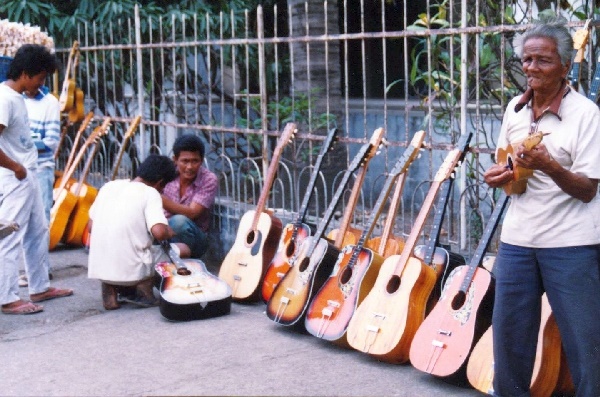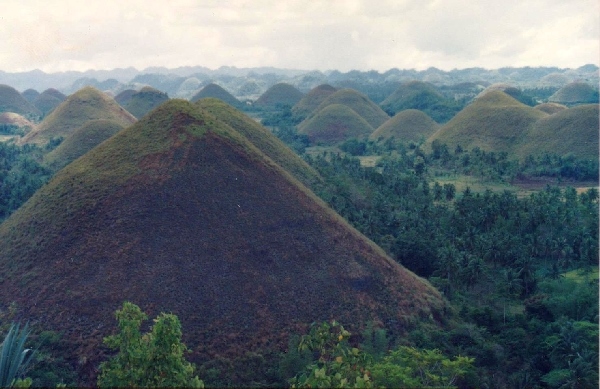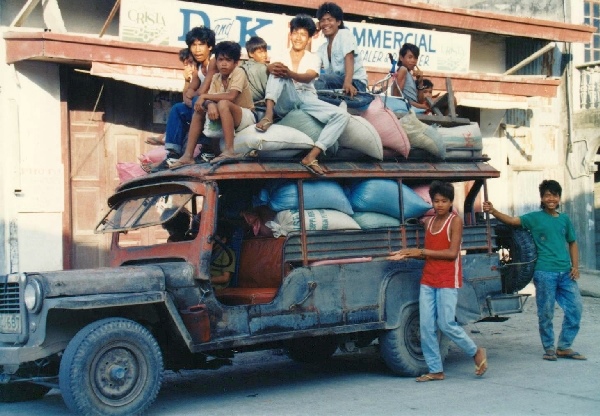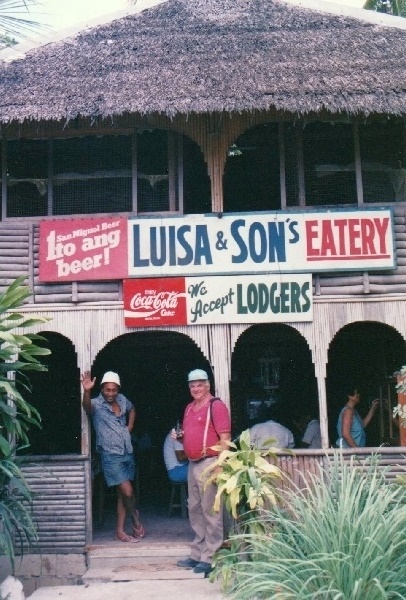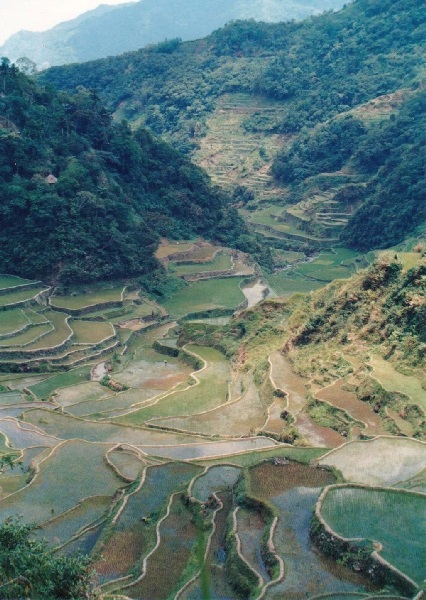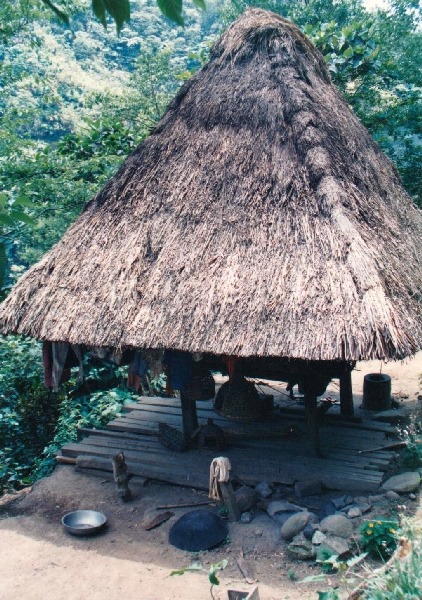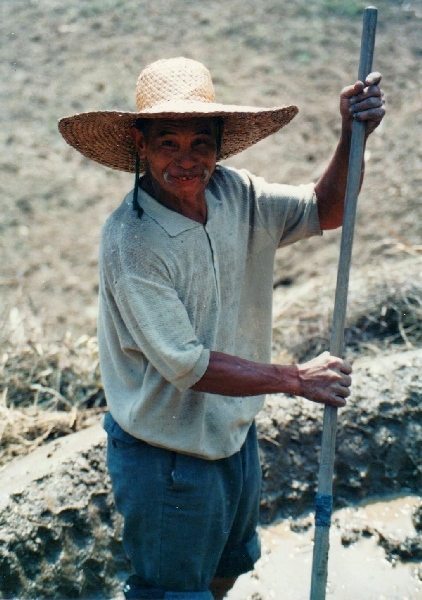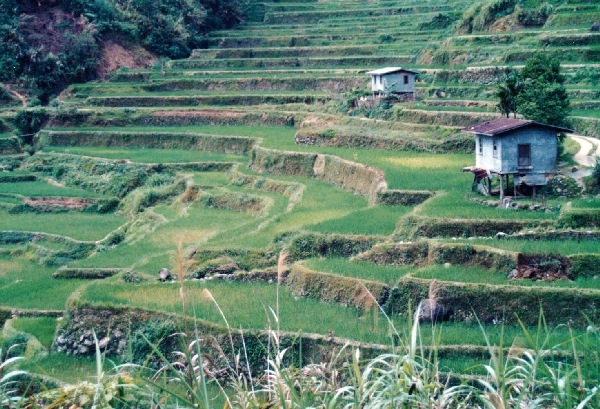World traveler Clown Tom Bolton
Adventure stories & photos

Tom’s travels in the Philippines
Manila, Luzon Island, Philippines
I arrived in the Philippines in early March 1990. It was not quite as culturally exotic as most other Asian countries but compared to India, where I had just spent 6 weeks, what country would be. English is spoken most everywhere so it has its practical aspects. I would also learn that many local dialects are full of simple Spanish words. The spellings were often strange but one could say something like “Hi, how’s it going friend? How much for a beer? Cheap! Bye” in Spanish and the locals would be asking where one had learned “their” language. The capital city Manila is on the island of Luzon and is large, dirty, hot and while not actually exciting, it did have a number of sites to see. Most interesting was the old quarter built by the Spanish in the 16th century called Intramuros, which was enclosed within high-fortified walls and entered through decorative gateways. It includes the Santiago Fort, lots of churches and cathedrals and the ruin of San Agustin Monastery.
Intramuros, central Manila
There were such horse drawn carriages in Intramuros, which offered tours through the area. Not the kind of thing that I would blow my budget on but it did add character to the setting. It was quite a contrast to the extensive slums where thousands even live as trash pickers on the city dump. In central Manila one saw many armed guards or soldiers with machine guns in front of the major museums and government buildings yet police other than a couple directing traffic were no where to be seen. I myself had one incident where a young guy approached me as if he were trying to sell newspapers. One hand pushed the paper up towards my face while the other quickly tried to grab for my money belt. I noticed right away and moved out of his way but imagine this diversion tactic, which he was quite smooth at, could be very effective. Since then I have taken up taekwondo and learned a bit about Filipino martial arts which unlike most such traditions are based on brutal techniques aimed at killing or maiming an enemy rather than having any spiritual or defensive aspects. One underestimates a hostile Filipino at their own risk!
Manila post office
This post office stood out as a typical government building one would see in America from 50 to 100 years ago, built in a classical style. Seems no coincidence that the Philippines were governed by the USA from 1989 – 1946. I never noticed much notable architecture in the Philippines other than what had been left by the Spanish hundreds of years ago. .
Filippino resentment of America
The poster below was protesting the American military bases, which still existed at the time. No nukes, no AIDS, no bases – showing a sailor with a claw like hand on a woman’s ass. Pretty much sums up how many viewed the Americans’ influence. One should know a bit of history though. The Spanish had colonized the country for a few hundred years. The Spanish-American war in the late 1890’s resulted in the ceding of the Philippines to America. The Americans quickly defeated the Filipinos in their consequential attempt at independence, which was finally granted in 1946. Paradoxically, the Filipinos both resent the American colonization yet regret that they are not still part of America. 99% of Filipinos seemed to think that all of their problems were somehow the fault of America yet they would give their left testicle to get a green card to reach the land of plenty where money just grows on trees. Many guys had a sister or daughter who, site unseen, would be more than happy to marry me, they said. I didn’t know it at the time and perhaps it has since changed but there was a provision that by serving in the US military, any Filipino would be granted a resident’s permit.
There was a story in the newspaper while I was there about how the American Supreme Court had upheld the “right” for the CIA to kill off foreign bad guys without trial. The writer went on to conclude that this would give the right for any American to suddenly cut your throat – so one should cut their throats first. Because of this, I didn’t advertise the fact that I was American. When asked, I told the truth, that I was born on a Caribbean island called Puerto Rico. The major American bases Clark and Subic Bay were later removed, not in deference to local feelings but because of heavy damage from the 1991 eruption of Mount Pinatubo volcano.
Manila cemetary
An unusual attraction in Manila was a large cemetery where many of the local Chinese community were buried. They built huge, elaborate mausoleums, which were literally marble mansions complete with kitchens, toilets, bars etc. Basically they were used as weekend vacation homes. The cemetery had at some point gotten run down and a plaque proclaimed how it was renovated in the 1960’s – the biggest difficultly being in getting rid of the families of squatters who were living there. Compared to the tin shacks of Manila’s millions of poor, these were villas worthy of the rich elite. This is a view inside one such mausoleum.
Cebu Island
From Manila I booked passage on a ship to the island of Cebu. I eventually got to the islands of Negros, Cabilao, Sequijor, Penay, Mindoro, Bohol and Boracay, all of which are in the central part of the Philippines collectively known as the Visayas. There were only about 150 to 200 people on board this ferry which was capable of carrying 1500 and I was the only non-local except for a couple with a first class suite who stayed out of sight the whole trip. I had heard horror stories of getting nothing but fish head soup on such journeys but the food was okay although I had to pick the meat out of the rice and veggies a few times.
There was a disco at night and not only did many boys dance with other boys, they even came and asked me to dance but I had the impression it was just innocent fun without any suggestion of homosexuality. Upon arrival in Cebu, our ship was greeted by a flotilla of small boats manned by people begging. Many on board played along and threw coins in the water, which the beggars quickly dove after. I wasn’t sure if the intentions were to help or degrade the poor but it seemed a sad situation.
Filippino cuisine
Having mentioned food, I would say that most meals I had in the Philippines were generally ok but rather bland compared to most Asian cuisines like Thai or Indian. Often one had rice and fish – for breakfast! Another specialty was roasted pig like seen at this street stall, even for people who eat such things one wonders how they can look at it, yuk.
Cebu Metropolitan Cathedral
Arriving in Cebu city, I ended up staying at a Catholic Center. It wasn’t a requirement but they asked me if I wasn’t a seminarian. Hah, good guess but not quite. The Spanish had established themselves first in Cebu, which was their capital before it got moved to Manila. They had built a fortification there called Fort San Pedro and again numerous churches. The impressive Cebu Metropolitan Cathedral was across from my accommodation.
Fort San Pedro, Manuel Lopez de Legazpi Conquistador statue
Fort San Pedro, the oldest Spanish fort left in the Philippines is in Cebu city. I don’t remember why I didn’t get more images of the location. Here I took the photo of the conquistador Manuel Lopez de Legazpi statue and the gardens. They certainly didn’t let anyone forget who evangelized the country! Every time I hear about how Islam spread through conquest, I think about such images from the Philippines and Latin America. No lack of blood was shed by the Catholic church extending its reach.
Religious images of Mary & Jesus
Inside the Cathedral were women wearing veils kissing and touching the statues with fanatical devotion. Inside and out were lots of kitschy statues, icons, crucifixes and paintings for sale. With the holy family and all of the saints represented, no wonder that one could confuse a monotheistic religion like Catholicism with a belief with multiple gods like Hinduism. Am I the only one to see a resemblance in their colorful, kitschy style of religious memorabilia?

Filippinos love music
Coming out of the fort were these blind musicians I saw playing on the street. I never met a people as amazingly musical as the Filipinos. Once I was on a beach and there were about 15 young Filipinos all of whom could sing well and they passed around a guitar which all of them could play as well. The other thing always asked in the Philippines was to “sing us a song from your country”, and they strongly disliked it when I said I REALLY can’t sing. Like…how about this juggling trick?!…Yeah, but NOW sing us a song! Oh F**k!
This passion for music was reflected in what I saw these street vendors selling – guitars! If you see a good rock band playing in Bangkok, Jakarta or Singapore, chances are that they are Filipinos, many of which work as musicians throughout Asia.
Basilica del Santo Niño de Cebu
Here is the Basilica del Santo Niño de Cebu, first church built by the Spanish in the Philippines. It houses the holy Santo Niño or Baby Jesus relic, which people flock to see. There was also a gallery of old painting glorifying the conquest of the Spanish over the hostile natives who were heathens in need of a good ass kicking and the Catholic religion. One painting showed the Spanish victorious on the battlefield, dead natives at their feet, with a beam of light shining from the heavens. Don’t think they mentioned that the attempts by Ferdinand Magellan lead to his death and following attempts also failed until they sent some cutthroats from Mexico to do the job.
Cabilao and Bohol Islands
From Cebu City I took a bus south to the city of Argao and from there a “pump” boat, a typically Filipino motorized outrigger canoe like shown below, across to the small island of Cabilao which lies just off the coast of Bohol Island. We waited and waited for the boat to leave but more people kept showing up, many with sacks of cement or jerry cans or whatever. By the time we departed, we were way over-loaded and riding low in the water. The sea wasn’t rough but it turned into a 2-hour journey and all of the locals were praying or crying that we would sink. The additional images are of the coast of Cabiao and the habor in Bohol.
Chocolate Hills
I stayed a few nights at the Estrella “resort” on Cabilao, which was nothing fancy, but affordable, with nice white sand beaches and palm trees around. The Philippines are lush, green tropical islands but don’t have many exceptional natural wonders. This photo shows one rather unique site known as the “Chocolate Hills” on the island of Bohol, which I visited on a day trip from Cabilao. There are various theories how these hills formed but when the grass covering them dries brown they look like the Hershey’s “kisses” chocolates sold in the USA. They were nice but after 20 minutes strolling around I had seen what there was to see yet the boats and jeepneys and bicycle-taxi rides costed me a whole day to get there and back.
Jeepney transportation
A common form of transportation throughout the Philippines is the jeepney. Jeeps were left here by the American military when the country was given independence after the end of the Second World War. They were customized to be very decorative and used like buses to transport people and merchandise. The custom has been well established although many of them are now created from vans and not jeeps. Pimp my ride has nothing on these vehicles which are commonly not just filled to the roof but also on top with people and supplies of all sorts. The first of these jeepney photos was taken on my route across Bohol to the Chocolate Hills.
Negros and Sequijor Islands
From Cabilao, I had to once again take a boat to the main seaport of Bohol called Tagbilaran from where I caught a boat to Dumaguete at the southern tip of Negros Island. I spent a night there in a real dive that advertised “single bed for 2 people for 12 hours”. Ate at a restaurant that had a chicken stall connecting right into the dining area. Guess people could pick out their bird and have it prepared. When my plate of food arrived, there were ants crawling on it and I saw lots of cockroaches in the sink. Next day I continued over to the small island of Siquijor, which was great.
I found the small shop/restaurant/guesthouse called Luisa and Sons Eatery. It was basically like staying in a private home with shared bathrooms and showers. My room was fine except that at night I heard rats running along the ceiling and climbing into my backpack. I had no food there but who knows what they might chew up. I would throw a shoe at them but within minutes they would be back again. There was no menu but you just told them what you wanted to eat. Everything was just put on your bill and I wondered if they would try to gouge me since was no price list. I did think the amount of beers on my tab seemed unrealistically high when I left but all together it was a nice place and a reasonable price for my stay. The older German guy in the photo spent a lot of time in the country and rode around his motorcycle with a local girl who looked to be about 16. The owner shown with his legs on the table was a laid back guy.
Larena, Sequijor Island
I often made small shows in the market places like in the following photos from the town of Larena, Sequijor Island, or in the evenings at the typical village disco, which would be some Christmas lights strung up at the local school’s basketball court. Surprisingly, the Filipinos are CRAZY about basketball. People always asked me where I was born and when I mentioned Puerto Rico, they ALL knew that the Filipinos beat Puerto Rico in Men’s Basketball at the 1960 Olympics in Rome. For a country of typically small people, I guess this was something to be overly proud of.
Convent in Lazi
The Spanish also left their mark on Sequijor Island. There were old churches and at the village of Lazi a large convent with multiple bell towers.
Sect on Demaguete Island
After my say on Siquijor I returned to Demaguete but this time I found a more interesting place for a couple of days further south near the town of Zamboanguita. It was a very simple accommodation built on a fantastic piece of land on the seafront called Starship 2000. The picture below shows the reception area. Hanging on the wall were quotes from the founder of this organization (cult!) Father Tropa. The followers wore no shoes, which “destroys the contact to Mother Earth”. They claimed to be into ecology but had lots of animals confined in small cages. When I asked if they were vegetarians, the response was, “no, but we don’t eat dog!” Was a photo of the guru in Pune, India wearing flowing robes so I suspected he had something to do with the Rajneesh Bhagwan sect. The sect members referred to themselves as “lamplighters” suggesting they shed some light on the darkness of this world. Seemed all Filipinos needed desperately to believe in something. It’s one of those places that during Easter, people have themselves whipped and nailed to a cross to show their devotion.
Salawaki Beach
I actually spent most of my time and ate my meals by the nearby Salawaki resort at Salawaki Beach, not cheap but good food. I remember a group of Koreans there that came in from diving all day, they proceeded to eat an endless banquette of seafood until they could barely stand and then went back out for a night dive. The following photos were from the beach there. I often juggled and entertained the kids who constantly asked to be my “pen-pal” which took me a while to understand as I kept misunderstanding something about being a “pimple”.
Filippinos poor but clean
This was a small kiosk typical in the Philippines. They sold cigarettes, small snacks and drinks and small packets of laundry powder. Looks like a good side job but I wondered how many families survived from such a business alone. In most other countries one would not necessarily find laundry soap in such a place. But I remarked that despite being poor and while their cloths might be well worn, Filipinos were generally very clean. Made me a bit self-conscious as I had been traveling and most of my cloths had gotten pretty grubby.
Three brothers’ store
Not sure where I took this photo but it was a very typical store. Catholic county, lots of big families, and so no wonder so many places were called 3 brothers or 5 sisters or something similar.
Across Penay to Boracay Island
From the Spaceship 2000, I blasted off in a jeepney to Demaguete, where I caught another jeepney northwest to the town of Bocolod. Scenery was green and picturesque but dusty and the ride was too bumpy to take photos. Saw a lot of sugarcane being cut with machetes and a smattering of rice plots between groves of bananas and coconut trees. Arrived in Bocolod with my Lonely Planet guide in my hand as I got out of vehicle and a few minutes later I didn’t have it any more so I must have left it behind in jeepney. Stayed a night at the local YMCA before getting a boat over to Iloilo City on the south-eastern coast of Panay Island, then took bus up to the northern most tip to get a boat over to Boracay.
Boracay is small but very commercialized with one resort or group of bungalows after the other. It was far from cheap but still good value as standards were high and there were probably 10 rooms available for every tourist. I stayed at the main beach, smartly named White Beach although all of the Boracay beaches had white sand. Nothing to do but hang out at the beach. I once tried to stroll through the jungle but thorns poked up through my flip-flops. I found most of the tourists to be rather standoffish and have no idea why. There were even some hot local babes who I’m sure were prostitutes. Not that I wanted any involvement with them but they weren’t friendly either. Guess they were waiting for some rich movie star to show up instead of a poor backpacker.
I Spent a week doing a lot of reading, practicing my juggling and philosophizing about life. But I felt unconnected to most of the other visitors. Took a few of the mandatory vacation shots of the sunset at the beach. For the time I spent there I hardly took a photo. Now I regret not having documented what was in Boracay rather than what was missing: any traditional or colonials building or influence. I was into artistic photos at the time and Boracay seemed about as interesting as a small town shopping mall.
Since I visited Boracay, it has developed into the number 1 tourist destination in the Philippines. Multitudes of hotels, bars and even shopping centers have blanketed the island. Rather than a place to relax, it is now the place to be seen. The simple guesthouses are over shadowed by luxury resorts where one can play golf on a top course. It’s not my idea of where to go in the Third World but it has also been an opportunity for many foreigners to establish a business. A good friend of mine who is a musician has even built a boat there that one can hire. One can see more about his boat and about various activities on Boracay at www.boracay-activities.com
Puerto Galera, Mindoro Island
From Boracay, I took a 6-hour boat ride north on rough seas to get to the town of Roxas on Mindoro Island. Then a bus ride to Calapan and a jeepney to Puerto Galera spent mostly on the roof since it was so crowded. The prices were higher and standards much lower than in Boracay, probably because it is much easier accessed from Manila so lot of Filipinos from the capital came to visit there, often crowding in 5 to a room to split the costs. I had a ratty shack of a bungalow, which was obviously not very secure.
Throughout the Philippines but especially in Puerto Galera. I would be strolling around and come upon some young Filipinos completely drunk and they would want to talk and complain how they were somehow victims and liked to act “crazy shit” and kill foreigners if they aren’t their friend. You could never tell where it would lead and frequently they would have machetes with them. The Filipino fighting arts rely first on weapons and they have 2 targets, the eyes and the testicles so one can forget the idea of a fair fight.
After a couple of days I caught one of the workers trying to break into my bungalow and when I reported it to the owner, she started to threaten me for making up lies. I was feed up anyway with the aggressive atmosphere of the locals and uninterested in the foreigners who seemed to mostly be fat old guys with their either bought or rented local girls, so I wisely left that day before I had someone try to cut my throat. I actually slept out by the beach and caught an early ferry to Luzon and an air-conditioned bus to Manila.
Banaue, Luzon highlands via Manila
I only had 5 days left but didn’t want to hang around Manila so I got a bus the next morning to Banaue in the north central part of Luzon. Getting a seat was difficult and I was worried if I would get back as the Easter season was coming up and lots of Filipinos would be traveling then. There was also a rebel movement active in this region of Luzon while I was there. I was in a bus near Banaue when 3 guys came in carrying automatic rifles.
They had on a sloppy mismatch of military clothing so I had doubts they could be normal soldiers. One sat in front of me and the others 2 seats behind me. I spoke to the guy in front and he told me there was a cease-fire because of Easter. Despite that, I had to sweat a bit not knowing if they were rebels or what; and if someone started shooting at them, I would be right in the middle. While hiking in the area, I met these kids and they wanted to play Rambo and act like they were shooting at me. It was of course just a game for them but still it makes one wonder.
Terraced rice paddies
Like in most of Asia, the Filipino cuisine is based on rice. There are extensive rice terraces throughout the country and it is said that the highland terraces of Luzon are actually a bigger architectural work than the Great Wall of China. Fish are also stocked in the rice paddies, they are another food source, help fertilize the rice and lower the insect population. And what photo adventure would be complete without some of the workers in the rice fields like the farmer below.
Back in Manila
I spent my last 2 days back in Manila and remember a Japanese guy at the hostel who had come down with malaria. He said he had had it while climbing Kilimanjaro in Tanzania and he would be okay but his fever got out of control and they had to take him to the hospital. It was right before Easter and the papers, in contrast to what I had heard in Banaue, wrote that there would be no cease-fire for the holiday and government troops were having lots of altercations with communist rebels. Most shops and restaurants were closed and I couldn’t send off any last minute postcards like I wanted to before I took a flight to Amsterdam.
So, those were just a few tales from my many travels over the last thirty and something years. I hope you've enjoyed another side of a traveling clown! If you want, write me an email or better yet, book my show or set a link to this website or just state me as the beneficiary of your will!
To book or see more information about Tom's clown show and entertainment, visit one or both of his clown websites:
Clown Stuttgart www.clowntombolton.com
Clown juggler Stuttgart, Gremany www.clown-event.de


















